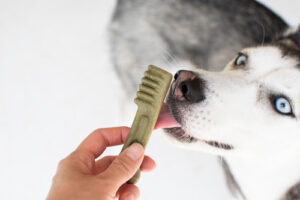Having a new litter is an exciting time, but it also can be worrisome if you don’t know what to expect with newborn puppies & kittens. Here are some guidelines to help make the experience the best possible!
Labor is traditionally divided into three stages:
- In the first stage, the mother may pant, cry, pace, hide, try to dig a nest, lick, and she usually stops eating. This can last between 12 and 24 hours.
- The second stage is when the mother is actively pushing and delivering puppies or kittens.
- The third stage is the delivery of the placenta.
These stages alternate until the entire litter is delivered. Sometimes there is not a placenta for each of the young, and that is alright.
As each of the young is delivered, the mother will lick it vigorously and use her front teeth to tear at the birth membranes and the umbilical cord. She will then lick the young until it is clean and dry. This licking serves to stimulate the young to breathe, helps to clear the fluid from their lungs, and also stimulates urination and defecation.
As the mother finishes with each of the newborn puppies or kittens, it will move down to her side to begin to nurse. The process of delivering the entire litter takes between 6 to 12 hours on average.
Some signs that there may be a problem and you should take the mother to a veterinarian are:
- Green/brown/red discharge with no delivery within 1 hour
- Weak contraction with no delivery within 3 hours
- Hard contractions with no delivery within 30 minutes
There is also more information on this in the breeding section of our web page.
As each of the young is born, examine them for any obvious birth defects or cleft palates. Open the mouth gently and look at the roof of the mouth. If there is a wide split, this individual will not be able to nurse, and you should seek assistance.
Once the young are born, they need to nurse! The first milk that is produced is called colostrum, and it contains important proteins that help the young fight disease. This can only be absorbed by the young in the first day of life, so if the young are not nursing well, please seek assistance from a veterinarian.
Weigh each puppy/kitten at birth, and keep a log book with the weight and some identifying features. A small piece of ribbon is commonly used to identify individuals when it is not easy to tell them apart. Weigh each individual twice a day and keep a record.
Just like with human infants, newborn puppies and kittens often lose a little weight in the first day or so, but after that they should gain weight steadily. Not doing so is a sign of a problem and needs quick intervention.
Normal newborn puppies & kittens nurse every couple of hours around the clock, and sleep in between meals during the early days.They are strong and able to move around the nest box, and are very vigorous in seeking and attaching to the nipple to feed.
After nursing, they should have an obviously round belly. The mother will lick them to stimulate them to urinate and defecate, but if you do see urine it should be clear, and stool is usually pasty and yellow-brown in color.
In the first few days after birth, the two biggest concerns are if the young get too cold, and if they are not nursing well. Cold infants cannot digest their meals and have reduced ability to fight disease. Nursing is the sole source of water and of calories for growth. Therefore, infants that are not nursing well get dehydrated and can develop a low blood sugar.
Signs of problems with the infants include:
- Crying
- Restlessness
- Cool to the touch
- Yellow urine (a sign of dehydration)
- Tremors, seizures, and loss of responsiveness
Any of these warrant a call to the veterinarian!
This is just a quick overview. In most cases “mother nature” takes care of everything, but it helps to know a few things to watch for just in case.
Julie Keene, MS, DVM, PhD




